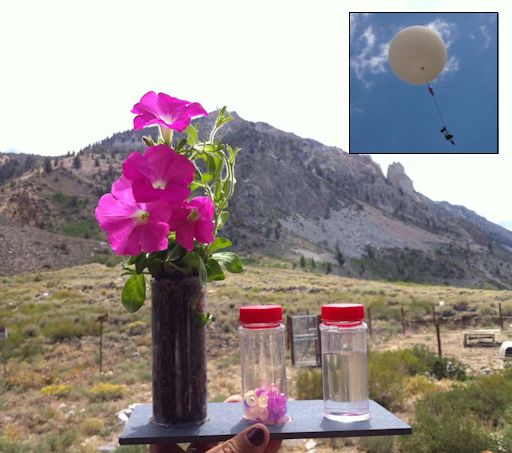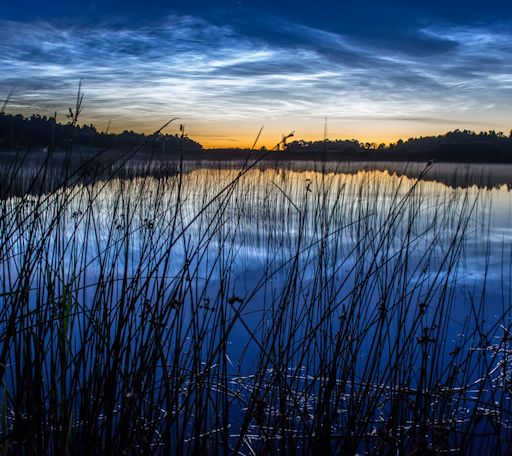Listen to radar echoes from satellites and meteors, live on listener-supported Space Weather Radio. | | |
CHANCE OF STORMS: A stream of high-speed solar wind is blowing past Earth. So far the low-density stream is doing little to spark geomagnetic storms. This could change, however, with a shift in the interplanetary magnetic field (IMF). A south-pointing IMF would allow this fast wind into Earth's magnetosphere, possibly sparking bright auroras. NOAA forecasters estimate a 50% chance of polar geomagnetic storms on July 20th. Aurora alerts: text, voice.
PETUNIAS AT THE EDGE OF SPACE: Yesterday, July 19th, Caleb Smith was hiking along the John Muir Trail in California's Sierra Nevada mountains when something unprecedented happened. A vase of petunias parachuted out of the sky. "They landed about 50 feet away from me," he reports. The flowers were returning from the stratosphere, where the students of Earth to Sky Calculus had sent them hours earlier to honor Cassini's historic photography of Earth through the rings of Saturn. Scroll past this pre-launch picture of the petunias to learn more about the mission:

The balloon was launched to photobomb Cassini's picture of Earth from the highest possible altitude. In addition to the petunias, the payload contained three scientific experiments, a copy of the Hitchhikers Guide to the Galaxy, and a Galileo Bobblehead. The items on board were selected competitively from more than 1056 entries suggested by Spaceweather.com readers. First place winners of the competition received free telescopes from Explore Scientific.
The petunias were a bouquet for the ringed planet. It honors Saturn's ancient mythology as a god of agriculture and also makes reference to the Hitchhikers Guide to the Galaxy. Fans of Douglas Adams will understand their significance!
In addition to the items aimed at Saturn, the balloon also carried a space weather experiment. A device combining a GPS altimeter and cryogenic thermometer was sent aloft to measure the height of the tropopause, the coldest layer of Earth's atmosphere. The students who launched the balloon want to see if this changes in response to solar flares and radiation storms.
Stay tuned for more information about the balloon's recovery. Updates are available on Twitter.
Realtime Space Weather Photo Gallery
NOCTILUCENT CLOUDS: Earth's "noctilucent daisy" is glowing brighter than ever. Seeded by meteor smoke, noctilucent clouds are surrounding the north pole in a luminous circle visible from ground and space alike. Tadas Janušonis photographed this display on July 18th from Vabalninkas in the Birzai district of Lithuania:

"This was the best show in the night sky I've seen this year by far," says Janušonis. "Noctilucent clouds were shining from twilight to dawn."
2013 is shaping up to be a great year for NLCs. The clouds surprised researchers by appearing early this year, and many bright displays have already been recorded. Once confined to the Arctic, NLCs have been sighted in recent years as far south as Utah, Colorado, and Nebraska. They might spread even farther south in 2013.
Observing tips: Look west 30 to 60 minutes after sunset when the sun has dipped 6o to 16o below the horizon. If you see luminous blue-white tendrils spreading across the sky, you've probably spotted a noctilucent cloud.
Realtime Noctilucent Cloud Photo Gallery
[previous years: 2003, 2004, 2005, 2006, 2007, 2008, 2009, 2011]
Realtime Aurora Photo Gallery
Realtime Comet Photo Gallery

